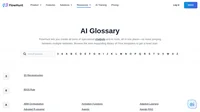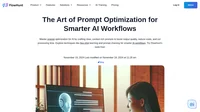Parameter-Efficient Fine-Tuning (PEFT) is an innovative approach in artificial intelligence (AI) and natural language processing (NLP) that allows the adaptation of large pre-trained models to specific tasks by updating only a small subset of their parameters. Instead of retraining the entire model, which can be computationally intensive and resource-demanding, PEFT focuses on fine-tuning select parameters or adding lightweight modules to the model architecture. This method significantly reduces computational costs, training time, and storage requirements, making it feasible to deploy large language models (LLMs) in a variety of specialized applications.
Why Is Parameter-Efficient Fine-Tuning Important?
As AI models continue to grow in size and complexity, the traditional fine-tuning approach becomes less practical. PEFT addresses these challenges by:
- Reducing Computational Costs: By fine-tuning only a fraction of the model’s parameters, PEFT lowers the computational and memory requirements.
- Enabling Scalability: Organizations can efficiently adapt large models to multiple tasks without the need for extensive resources.
- Preserving Pre-Trained Knowledge: Keeping most parameters frozen helps maintain the general understanding the model has acquired.
- Faster Deployment: Reduced training times accelerate the deployment of models in production environments.
- Facilitating Edge Computing: Makes it feasible to deploy AI models on devices with limited computational capabilities.
How Does Parameter-Efficient Fine-Tuning Work?
PEFT encompasses several techniques designed to update or augment pre-trained models efficiently. Below are some of the key methods:
1. Adapters
Overview:
- Function: Adapters are small neural network modules inserted into the layers of a pre-trained model.
- Operation: During fine-tuning, only the adapter parameters are updated, while the original model’s parameters remain frozen.
Implementation:
- Structure:
- Down-Projection: Reduces dimensionality (
W_down). - Non-Linearity: Applies an activation function (e.g., ReLU, GELU).
- Up-Projection: Restores original dimensionality (
W_up).
- Down-Projection: Reduces dimensionality (
Benefits:
- Modularity: Easily add or remove adapters for different tasks.
- Efficiency: Significant reduction in trainable parameters.
- Flexibility: Supports multitask learning by swapping adapters.
Use Case Example:
- Domain Adaptation: A global company wants its language model to understand regional colloquialisms. By adding adapters trained on regional data, the model can adapt without full retraining.
2. Low-Rank Adaptation (LoRA)
Overview:
- Function: Introduces trainable, low-rank matrices to approximate weight updates.
- Operation: Decomposes weight updates into lower-dimensional representations.
Mathematical Foundation:
- Weight Update:
ΔW = A × B^TAandBare low-rank matrices.r, the rank, is chosen such thatr << d, wheredis the original dimensionality.
Advantages:
- Parameter Reduction: Drastically decreases the number of parameters needed for fine-tuning.
- Memory Efficiency: Lower memory footprint during training.
- Scalability: Well-suited for very large models.
Considerations:
- Rank Selection: Important to balance between performance and parameter efficiency.
Use Case Example:
- Specialized Translation: Adapting a general translation model to a specific domain, like legal documents, by fine-tuning with LoRA.
3. Prefix Tuning
Overview:
- Function: Adds trainable prefix tokens to the inputs of each transformer layer.
- Operation: Influences the model’s behavior by modifying the self-attention mechanism.
Mechanism:
- Prefixes: Sequences of virtual tokens that are optimized during training.
- Self-Attention Influence: Prefixes affect key and value projections in attention layers.
Benefits:
- Parameter Efficiency: Only prefixes are trained.
- Task Adaptability: Can effectively guide the model toward specific tasks.
Use Case Example:
- Conversational AI: Tailoring a chatbot’s responses to adhere to a company’s brand voice.
4. Prompt Tuning
Overview:
- Function: Adjusts trainable prompt embeddings added to the input.
- Difference from Prefix Tuning: Typically affects only the input layer.
Mechanism:
- Soft Prompts: Continuous embeddings optimized during fine-tuning.
- Optimization: Model learns to map from prompts to desired outputs.
Benefits:
- Extremely Parameter-Efficient: Requires tuning only a few thousand parameters.
- Ease of Implementation: Minimal changes to the model architecture.
Use Case Example:
- Creative Writing Assistance: Guiding a language model to generate poetry in a specific style.
5. P-Tuning
Overview:
- Extension of Prompt Tuning: Inserts trainable prompts at multiple layers.
- Goal: Enhance performance on tasks with limited data.
Mechanism:
- Deep Prompting: Prompts are integrated throughout the model.
- Representation Learning: Improves the model’s ability to capture complex patterns.
Benefits:
- Improved Performance: Particularly in few-shot learning scenarios.
- Flexibility: Adapts to more complex tasks than prompt tuning alone.
Use Case Example:
- Technical Question Answering: Adapting a model to answer domain-specific questions in engineering.
6. BitFit
Overview:
- Function: Fine-tunes only the bias terms of the model.
- Operation: Leaves the weights of the network unchanged.
Benefits:
- Minimal Parameter Update: Bias terms are a tiny fraction of total parameters.
- Surprisingly Effective: Achieves reasonable performance on various tasks.
Use Case Example:
- Quick Domain Shift: Adjusting a model to new sentiment data without extensive training.
Comparing PEFT to Traditional Fine-Tuning
| Aspect | Traditional Fine-Tuning | Parameter-Efficient Fine-Tuning |
|---|---|---|
| Parameter Updates | All parameters (millions/billions) | Small subset (often <1%) |
| Computational Cost | High (requires significant resources) | Low to moderate |
| Training Time | Longer | Shorter |
| Memory Requirement | High | Reduced |
| Risk of Overfitting | Higher (especially with limited data) | Lower |
| Model Deployment Size | Large | Smaller (due to additional lightweight modules) |
| Preservation of Pre-Trained Knowledge | May diminish (catastrophic forgetting) | Better preserved |
Applications and Use Cases
1. Specialized Language Understanding
Scenario:
- Healthcare Industry: Understanding medical terminology and patient reports.
Approach:
- Use Adapters or LoRA: Fine-tune the model on medical data by updating minimal parameters.
Outcome:
- Improved Accuracy: Better interpretation of medical texts.
- Resource Efficiency: Adaptation without the need for extensive computational power.
2. Multilingual Models
Scenario:
- Expanding Language Support: Adding low-resource languages to existing models.
Approach:
- Adapters for Each Language: Train language-specific adapters.
Outcome:
- Accessible AI: Supports more languages without retraining the entire model.
- Cost-Effective: Reduces the resources needed to add each new language.
3. Few-Shot Learning
Scenario:
- New Task with Limited Data: Classifying a new category in an existing dataset.
Approach:
- Prompt or P-Tuning: Use prompts to guide the model.
Outcome:
- Rapid Adaptation: Model adapts quickly with minimal data.
- Maintains Performance: Achieves acceptable accuracy levels.
4. Edge Deployment
Scenario:
- Deploying AI on Mobile Devices: Running AI applications on smartphones or IoT devices.
Approach:
- BitFit or LoRA: Fine-tune models to be lightweight for edge devices.
Outcome:
- Efficiency: Models require less memory and processing power.
- Functionality: Delivers AI capabilities without server reliance.
5. Rapid Prototyping
Scenario:
- Testing New Ideas: Experimenting with different tasks in research.
Approach:
- PEFT Techniques: Quickly fine-tune models using adapters or prompt tuning.
Outcome:
- Speed: Faster iterations and testing cycles.
- Cost Savings: Less resource-intensive experimentation.
Technical Considerations
Selection of PEFT Method
- Task Nature: Some methods are better suited for certain tasks.
- Adapters: Good for domain adaptation.
- Prompt Tuning: Effective for text generation tasks.
- Model Compatibility: Ensure the PEFT method is compatible with the model architecture.
- Resource Availability: Consider computational constraints.
Hyperparameter Tuning
- Learning Rates: May need adjustment based on the PEFT method.
- Module Size: For adapters and LoRA, the size of added components can impact performance.
Integration with Training Pipelines
- Framework Support: Many frameworks like PyTorch and TensorFlow support PEFT methods.
- Modular Design: Adopt a modular approach for easier integration and testing.
Challenges and Considerations
- Underfitting: Too few parameters may not capture the task complexity.
- Solution: Experiment with module sizes and layers where PEFT is applied.
- Data Quality: PEFT cannot compensate for poor-quality data.
- Solution: Ensure data is clean and representative.
- Over-Reliance on Pre-Trained Knowledge: Some tasks may require more adaptation.
- Solution: Consider hybrid approaches or partial fine-tuning.
Best Practices
Data Handling
- Curate High-Quality Data: Focus on relevance and clarity.
- Data Augmentation: Use techniques to expand limited datasets.
Regularization Techniques
- Dropout: Apply to PEFT modules to prevent overfitting.
- Weight Decay: Regularize parameters to maintain stability.
Monitoring and Evaluation
- Validation Sets: Use to monitor performance during training.
- Bias Checks: Evaluate models for potential biases introduced during fine-tuning.
Advanced Topics
Hypernetwork-Based PEFT
- Concept: Use a hypernetwork to generate task-specific parameters.
- Benefit: Dynamic adaptation to multiple tasks.
Combining PEFT Methods
- Composite Techniques: Merge adapters with LoRA or prompt tuning.
- Optimization Strategies: Jointly optimize multiple PEFT modules.
Frequently Asked Questions
- Can PEFT methods be applied to any model?
- While primarily developed for transformer-based models, some PEFT methods can be adapted to other architectures with modifications.
- Will PEFT methods always match full fine-tuning performance?
- PEFT often achieves comparable performance, but in highly specialized tasks, full fine-tuning might offer marginal improvements.
- How do I choose the right PEFT method?
- Consider the task requirements, resource availability, and previous success on similar tasks.
- Is PEFT suitable for large-scale deployments?
- Yes, PEFT’s efficiency makes it ideal for scaling models across various tasks and domains.
Key Terms
- Transfer Learning: Leveraging a pre-trained model on new tasks.
- Large Language Models (LLMs): AI models trained on extensive text data.
- Catastrophic Forgetting: Loss of previously learned knowledge during new training.
- Few-Shot Learning: Learning from a small number of examples.
- Pre-Trained Parameters: Model parameters learned during initial training.
Research on Parameter-Efficient Fine-Tuning
Recent advancements in parameter-efficient fine-tuning techniques have been explored through various scientific studies, shedding light on innovative methods to enhance AI model training. Below are summaries of key research articles that contribute to this field:
- Keeping LLMs Aligned After Fine-tuning: The Crucial Role of Prompt Templates (Published: 2024-02-28)
Authors: Kaifeng Lyu, Haoyu Zhao, Xinran Gu, Dingli Yu, Anirudh Goyal, Sanjeev Arora
This paper investigates the alignment safety of large language models (LLMs) post fine-tuning. The authors highlight that even benign fine-tuning can lead to unsafe behaviors in models. Through experiments on several chat models such as Llama 2-Chat and GPT-3.5 Turbo, the study reveals the importance of prompt templates in maintaining safety alignment. They propose the “Pure Tuning, Safe Testing” principle, which suggests fine-tuning without safety prompts but including them during testing to mitigate unsafe behaviors. The results from fine-tuning experiments show significant reductions in unsafe behaviors, emphasizing the effectiveness of this approach. Read more - Tencent AI Lab – Shanghai Jiao Tong University Low-Resource Translation System for the WMT22 Translation Task (Published: 2022-10-17)
Authors: Zhiwei He, Xing Wang, Zhaopeng Tu, Shuming Shi, Rui Wang
This study details the development of a low-resource translation system for the WMT22 task on English-Livonian translation. The system utilizes M2M100 with innovative techniques such as cross-model word embedding alignment and gradual adaptation strategy. The research demonstrates significant improvements in translation accuracy, addressing previous underestimations due to Unicode normalization inconsistencies. Fine-tuning with validation sets and online back-translation further boosts performance, achieving notable BLEU scores. Read more - Towards Being Parameter-Efficient: A Stratified Sparsely Activated Transformer with Dynamic Capacity (Published: 2023-10-22)
Authors: Haoran Xu, Maha Elbayad, Kenton Murray, Jean Maillard, Vedanuj Goswami
The paper addresses the parameter inefficiency in Mixture-of-experts (MoE) models, which employ sparse activation. The authors propose Stratified Mixture of Experts (SMoE) models to allocate dynamic capacity to different tokens, thus improving parameter efficiency. Their approach successfully demonstrates improved performance across multilingual machine translation benchmarks, showcasing the potential for enhanced model training with reduced computational overhead. Read more
The Art of Prompt Optimization for Smarter AI Workflows
Master prompt optimization for AI with FlowHunt. Enhance output quality, reduce costs, and streamline workflows. Try a 14-day free trial!
Feature Engineering and Extraction
Explore how Feature Engineering and Extraction boost AI model performance by transforming raw data into valuable insights. Learn key techniques and examples!
Generative pre-trained transformer (GPT)
Discover how GPT revolutionizes text generation with AI, enhancing content creation, chatbots, and more. Explore its workings and applications!



